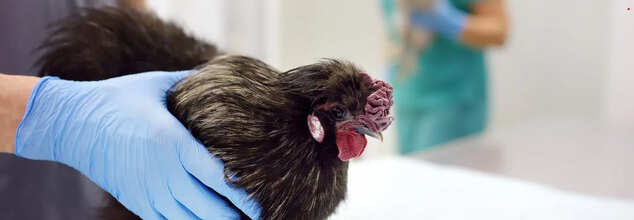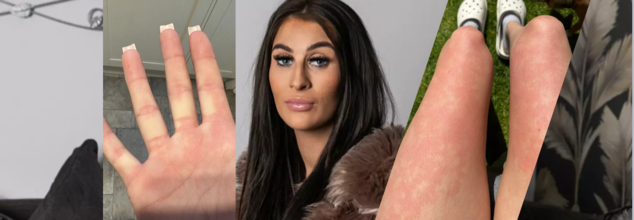
Credit: Canva
India Confirms 1st Bird Flu Human Death In 4 Years—Know Everything About It
India has reported its second human fatality due to highly pathogenic avian influenza (HPAI) or bird flu, marking the first such death in four years. While bird flu infections in humans are rare, they are highly lethal, with a fatality rate of one in two cases. The most recent victim was a two-year-old girl from Palnadu, Andhra Pradesh, who passed away in mid-March after being hospitalized for over 10 days at the All India Institute of Medical Sciences (AIIMS), Mangalgiri.
The pathogen responsible for the infection and subsequent deaths was confirmed only on 31 March, following a survey by the Indian Council of Medical Research-National Institute of Virology (ICMR-NIV). According to details shared by the state government, the child, who had a habit of consuming raw chicken, was admitted to the hospital on 4 March with symptoms including fever, breathlessness, nasal discharge, seizures, diarrhea, and reduced feeding. Two days before falling ill, she had reportedly consumed raw chicken. She succumbed to the infection 12 days later.
In a statement issued on Wednesday, the state government noted that no abnormal cases of respiratory infections had been identified in the ongoing survey. However, surveillance will continue for the next two weeks, with testing arranged for any suspected cases. Union health ministry officials stated that, based on data from the Integrated Disease Surveillance Programme (IDSP), no unusual surge in influenza-like illness (ILI) or severe acute respiratory illness (SARI) cases has been observed in the district in recent weeks.
A national joint outbreak response (NJOR) team has been deployed to conduct an epidemiological investigation and provide assistance to the state.
3 States Impacted By Bird Flu
This year, outbreaks of HPAI—also known as Influenza A virus subtype H5N1 or bird flu—have been reported in Maharashtra, Karnataka, and Andhra Pradesh. The trend follows a similar pattern observed in 2024, when states such as Jharkhand and Kerala, along with the aforementioned three states, recorded widespread H5N1 infections in poultry, prompting authorities to cull thousands of birds.The Union government emphasized that "human-to-human transmission of the H5N1 virus is uncommon, and the risk of any other epidemiologically linked case being reported is assessed to be low."
India's first recorded human infection of the H5N1 influenza virus occurred in 2021 when an 18-year-old boy in Haryana succumbed to the infection within days of contracting it.
In May last year, Australia reported its first human infection with H5N1, stating that the patient had acquired the virus in India. Towards the end of 2024, the deaths of four big cats—three tigers and a leopard—were attributed to H5N1 infection.

Credits: SWNS
'Even Drinking Water Burns My Throat', Rare Water Allergy Leaves UK Woman In Agonising Pain- What Is Aquagenic Urticaria?
For most of us, a hot or even a cold shower is luxury. For 26-year-old mom Joanna Watkins, it is torture. She has an extremely rare condition called Aquagenic Urticaria—a water allergy. From showering to tears, and even sweating, any exposure to water triggers intense burning, itching, and hives that last for hours on end.
And this is the kicker—she developed this condition in pregnancy. What started out as some minor irritation of the skin soon became excruciating pain with every drop of water. Now, something as ordinary as washing her hands, walking in the rain, or even drinking a glass of water is no longer routine—it's an act of courage.
Here, we consider what it truly is to live in a body that rejects the most basic building block of life, how she manages motherhood within it all, and the larger conversation surrounding invisible illnesses that affect not only the body—but every aspect of daily living.
This strange and mostly misjudged allergy to water has turned mundane daily activities into frightening experiences. From coping with her pregnancy to tending her toddler, Kendall navigates cautiously through her life, hoping for relief from a condition whose origins and essence are still poorly understood—by many physicians and medical researchers themselves.
What is Aquagenic Urticaria?
Aquagenic urticaria, also referred to as "water allergy," is a rare condition wherein the skin responds to contact with water at any temperature or level of cleanliness. Upon exposure, patients typically experience burning hives, redness, and itching within minutes. The condition is found in fewer than 100 people all over the world and occurs more often in women.
In Kendall's instance, even sweat or tears from her can trigger a skin reaction that is painful. "When it started, it was like I was being stung all over my body with nettles," she recollects. "Now it is like someone has held a flame to my skin."
Kendall first became ill at 15 years of age after breaking out in hives following a shower. She was initially kept under control using over-the-counter antihistamines like Piriton. Gradually, though, her condition worsened. It was not until 2021, nearly a decade later, that she was officially diagnosed by a dermatologist from the University Hospital of North Durham.
Even after diagnosis, treatment and information regarding it is limited. "The GP didn't know what to do. It's just so odd a condition, not many people have it, and not many people have even heard of it," she says.
Life at the Mercy of the Weather
Having aquagenic urticaria has placed Kendall in a highly regimented lifestyle. She checks the weather every day, avoiding rain as well as hot, humid conditions. "If I find myself outside unexpectedly, my body reacts and it hurts so much," she says. Her exposure to water is so limited that she can take a shower or bath every other day—having someone close at hand in case her body closes up.
"I cry through the process. It takes two hours, though it only takes half an hour. It's that bad my body goes into shock," she says. During these episodes, Kendall needs someone to look after her son, demonstrating just how far this condition reaches into every area of her life.
One of the hardest aspects of Kendall’s condition is how it impairs her ability to care for her child. “I’ve never been able to give my one-year-old son a bath. My mom has to do it for me,” she says, visibly distressed. Even drinking water causes a burning sensation in her throat, leaving her constantly dehydrated and exhausted.
The illness has left her feeling alone and powerless. "At the moment, everything feels so humiliating. I just want a normal life where I can go out in the rain, have a shower, and bathe my son," she says.
What Causes Aquagenic Urticaria?
Though the exact cause is unclear, researchers have proposed two major theories:
Interaction between water and sebum: Water may alter the skin's natural oils (sebum), stimulating mast cells to discharge histamines, resulting in hives.
Water as a carrier: Water may dissolve foreign allergens or irritants on the skin, inducing an immune reaction.
Due to the infrequency of the condition, studies are few and facts are mostly anecdotal or case-study oriented.
Can Water Allergy be Treated?
There is not yet a verified treatment for aquagenic urticaria. It is treated symptomatically with a variety of the following:
Oral antihistamines: Often the first line of therapy.
Topical therapy: In the form of corticosteroid cream and skin barriers.
Phototherapy: UV therapy to desensitize the skin.
Other medication: Including drugs used for asthma, anabolic steroids, and SSRIs (Selective Serotonin Reuptake Inhibitors).
Unfortunately, due to the fact that she is pregnant, Kendall's treatment opportunities are now minimal. "They've tried many different medications, but I continued to react. I still have not found anything that works," she says. After she delivers her baby, she would like to return to attempting more aggressive treatment.
Kendall is sharing her story in the belief that someone out there will be able to tell her something new about her condition, or suggest a new lead in treatment. "I do hope that someone might ring up and know what to do," she says.
Her vulnerability and resilience come across in every sentence. Though aquagenic urticaria is a medically rare condition, its psychological effect on sufferers and their families is very real.

Credit: Canva
5 Things That Hemophilia Patients Wish You'd Know About Their Condition
Hemophilia is a rare, genetic blood disorder, that causes your blood to clot less, resulting in an increased risk of bleeding and bruising. The platelets and proteins in the plasma work together to stop the bleeding by forming a clot over the injury. Hemophilia occurs when your body doesn't make enough of these clotting factors.
What Are The Symptoms Of Hemophilia?
- The most significant symptom is unusual or excessive bleeding or bruising.
- People with hemophilia may develop large bruises after minor injuries. This is a sign of bleeding under the skin.
- They may bleed for an unusually long time, whether after surgery, after dental treatment or simply from a cut finger.
- They may start bleeding for no apparent reason, such as sudden nosebleeds.
How To Identify Hemophilia In Babies
Babies and toddlers may bleed from their mouths after minor injuries, like bumping their mouths on a toy.
Babies and toddlers who bump their heads often develop goose eggs — large round lumps on their heads.
These symptoms may happen if babies and toddlers have internal bleeding into a muscle or joint. They may have areas on their bodies that look bruised and swollen, feel warm to your touch or make your child hurt when you gently touch the area.
A hematoma is a mass of congealed blood that gathers under babies’ or toddlers’ skin. Babies and toddlers may develop hematomas after receiving an injection.
Here Are 5 Things That Hemophilia Patients Wish You'd Know
Dr Nivedita Dhingra, Associate Director, Haematology and Bone Marrow Transplant, Max Super Speciality Hospital Patparganj, listed 5 things that Hemophilia patients wish you'd know about their condition.
1. Hemophilia is a congenital bleeding disorder.
It is usually inherited and predominantly affects males, though females can be carriers. The disorder impairs the blood’s ability to clot properly.
2. Affected people tend to have prolonged bleeding from minor injuries, and in severe forms, spontaneous bleeding into the joints can lead to deformities. This joint bleeding, called hemarthrosis, can be extremely painful and may result in long-term disability if left untreated.
3. It occurs due to the reduction or absence of clotting proteins and is classified as Hemophilia A when Factor VIII is deficient and Hemophilia B when Factor IX is reduced. Both types have similar symptoms but differ in genetic mutations and treatment approaches.
4. Timely diagnosis and initiation of treatment with factor concentrates can greatly minimise bleeding episodes and allow patients to lead productive lives. Prophylactic therapy, where clotting factors are regularly infused, is particularly effective in preventing joint damage and other complications.
5. Intrauterine testing and prenatal diagnosis are recommended. These help at-risk families make informed reproductive choices and prepare for early intervention after birth.

Credit: Canva
Bryan Johnson Quits Longevity Drug After It Accelerated Its Ageing
US tech billionaire and anti-ageing advocate Byran Johnson has revealed a major miscalculation involving a drug he once believed was a cornerstone of his protocol: Rapamycin. He said that the immunosuppressant, originally developed for organ transplant patients and now touted in anti-ageing circles, was something he had been experimenting with for five years. However, instead of reversing his age, it resulted in some serious.
Inspired by a 2009 study that showed rapamycin could extend the lifespan of mice by up to 14%, along with a 2023 human trial where 65% of participants reported feeling healthier while on the drug, Johnson began carefully fine-tuning his dosage in hopes of maximizing benefits while minimizing risks.
But instead of enhanced vitality, the tech entrepreneur began noticing a series of unsettling side effects like:
1. Mouth Ulcers
2. Delayed Wound Healing
3. Elevated Cholesterol
4. Spike In Blood Sugar
5. Rise in Resting Heart Rate
What Does Science Say?
Recently, a study conducted on the same by Yale University researchers supported Johnson's view, stating that the drug might accelerate biological ageing. Researchers identified 16 adverse effects on epigenetic markers (biological indicators tied to ageing), raising serious concerns about Rapamycin's long-term use as a longevity enhancer.
While Johnson concluded that he has stopped taking rapamycin, he underscored that this isn't a defeat but rather a strategic pivot. "This is not the end-this is a reset," he said. "It's important to share both wins and failures. That's how progress is made."
What Is Rapamycin?
Rapamycin is an immunosuppressant (medication that reduces the body's immune response) commonly used for organ transplant patients to prevent organ rejection. It is also called sirolimus and has been previously shown to extend the life span in multiple models. According to Essential Interventional Cardiology, it is a natural macrocyclic lactone that binds to specific cytosolic proteins called FK506 binding protein, which blocks G1 to S cell cycle progression by inhibiting the activation of a protein known as mTOR (mammalian target of rapamycin).
Johnson Is Building New Religion
This comes as the 47-year-old announced that he is building a new religion that is aimed at saving human life. In a series of X posts, Johnson introduced his new ideology, "Don't Die", which he believes is the key to human survival and aligns artificial intelligence (AI) with humanity's best interests. "Don't Die is the next great framework. It's how we transition into the era of AI and solving death," he wrote in one of his posts. The tech millionaire also announced the launch of his new app and urged people to be a part of it to become those who can be "admired and respected" by the 25th century.
"Dear humanity, I am building a religion. Wait a second, I know what you're going to say. Hold that knee-jerk reaction and let me explain. First, here's what's going to happen: + Don't Die becomes history's fastest-growing ideology. + It saves the human race. + And it ushers in an existence more spectacular than we can imagine. It is inevitable. The only question is: will you be an early or late adopter?" he wrote.
© 2024 Bennett, Coleman & Company Limited

